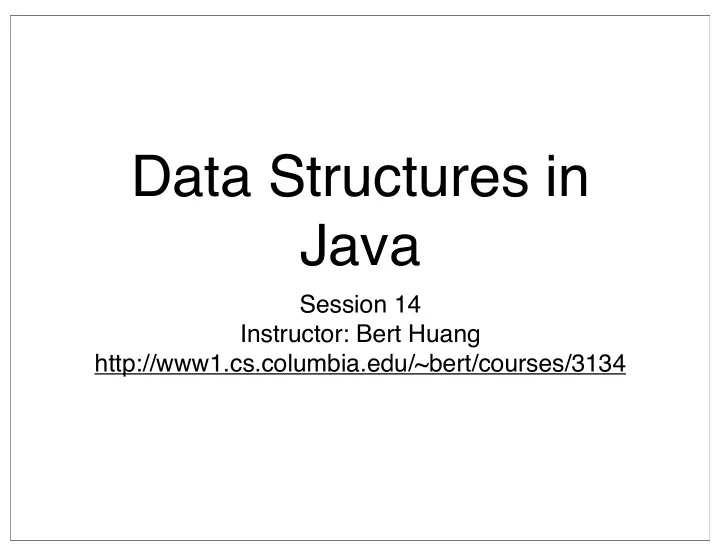

Data Structures in Java Session 14 Instructor: Bert Huang http://www1.cs.columbia.edu/~bert/courses/3134
Announcements • Homework 3 Programming due • Homework 4 on website
Review • Lists, Stacks, Queues • Trees, Binary Search Trees • AVL, Splay • Priority Queues: Binary Heaps
Today ʼ s Plan • Hash Table ADT • Array implementation • Collision resolution strategies
Hash Table ADT • Search tree: findMin, findMax, insert/delete, search • Priority Queue: findMin (or max), insert/delete, no search • Hash Table: insert/delete, search
Hash Table ADT • Search tree: Stores complete order information • Priority Queue: Stores incomplete order information • Hash Table: Stores no order information
Hash Table ADT • Insert or delete objects by key • Search for objects by key • No order information whatsoever • Ideally O(1) per operation
Implementation • Suppose we have keys between 1 and K • Create an array with K entries • Insert, delete, search are just array operations 1 2 3 4 5 6 ... K-3 K-2 K-1 K • Obviously too expensive
Hash Functions • A hash function maps any key to a valid array position • Array positions range from 0 to N-1 • Key range possibly unlimited 1 2 3 4 5 6 ... K-3 K-2 K-1 K 0 1 ... N-2 N-1
Hash Functions • For integer keys, (key mod N) is the simplest hash function • In general, any function that maps from the space of keys to the space of array indices is valid • but a good hash function spreads the data out evenly in the array • A good hash function avoids collisions
Collisions • A collision is when two distinct keys map to the same array index • e.g., h(x) = x mod 5 h(7) = 2, h(12) = 2 • Choose h(x) to minimize collisions, but collisions are inevitable • To implement a hash table, we must decide on collision resolution policy
Collision Resolution • Two basic strategies • Strategy 1: Separate Chaining • Strategy 2: Probing; lots of variants
Strategy 1: Separate Chaining • Keep a list at each array entry • Insert(x): find h(x), add to list at h(x) • Delete(x): find h(x), search list at h(x) for x, delete • Search(x): find h(x), search list at h(x)
Separate Chaining Average Case • Load Factor = # objects / TableSize λ • Average list length is λ • Time to insert = constant, or constant + λ • Time to search = constant + or constant + λ / 2 λ
Strategy 1: Advantages and Disadvantages • Advantages: • Simple idea • Removals are clean * • Disadvantages: • Need 2 nd data structure, which causes extra overhead if the hash function is good
Strategy 2: Probing • If h(x) is occupied, try h(x)+f(i) mod N for i = 1 until an empty slot is found • Many ways to choose a good f(i) • Simplest method: Linear Probing • f(i) = i
Linear Probing Example • N = 5 • h(x) = x mod 5 • insert 7 7 • insert 12 7 12 • insert 2 7 12 2
Primary Clustering x x x x x • If there are many collisions, blocks of occupied cells form: primary clustering • Any hash value inside the cluster adds to the end of that cluster • (a) it becomes more likely that the next hash value will collide with the cluster, and (b) collisions in the cluster get more expensive
Removals • How do we delete when probing? • Lazy-deletion: mark as deleted, • we can overwrite it if inserting, • but we know to keep looking if searching.
Quadratic Probing • f(i) = i^2 • Avoids primary clustering • Sometimes will never find an empty slot even if table isn ʼ t full! λ ≤ 1 • Luckily, if load factor , 2 guaranteed to find empty slot
Quadratic Probing Example • N = 7 • h(x) = x mod 7 • insert 9 9 • insert 16 9 16 • insert 2 9 16 2
Double Hashing • If is occupied, probe according to h 1 ( x ) f ( i ) = i × h 2 ( x ) • 2 nd hash function must never map to 0 • Increments differently depending on the key
Double Hashing Example • N = 7 • h1(x) = x mod 7, h2(x) = 5-x mod 5 • insert 9 9 • insert 16 9 16 • insert 2 9 2 16
Hashing • Indexing by the key needs too much memory • Index into smaller size array, pray you don ʼ t get collisions • If collisions occur, • separate chaining, lists in array • probing, try different array locations
Reading • Weiss Ch. 5
Recommend
More recommend